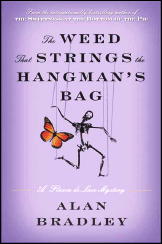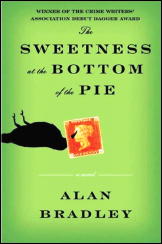Thu 17 Jun 2010
Reviewed by LJ Roberts: ALAN BRADLEY – The Weed That Strings the Hangman’s Bag.
Posted by Steve under Bibliographies, Lists & Checklists , Characters , Reviews[4] Comments
Reviews by L. J. Roberts
ALAN BRADLEY – The Weed That Strings the Hangman’s Bag. Delacorte Press, hardcover, March 2010. Trade paperback: Bantam, December 2010.
Genre: Traditional mystery. Leading character: Flavia de Luce, 2nd in series. Setting: England, 1950s.

First Sentence: I was lying dead in the churchyard.
Ten-year-old Flavia de Luce is ignored by her father, and continually set upon by her sisters. To compensate, she has her grandfather’s old laboratory, where she indulges her love of chemistry and skill with poisons, her bicycle, Gladys, and her skill at solving puzzles.
In The Weed That Strings Flavia befriends a beloved BBC puppeteer, Rupert Porson, and his “assistant,” who are stranded with a broken-down fan. When Rupert is electrocuted during a performance of “Jack and the Beanstalk,” Flavia knows it was no accident and finds that Rupert’s claims of not knowing anyone in the area were less than truthful.
Flavia de Luce has quickly become one of my favorite characters. At ten years old, she is still a young girl, albeit a brilliant one, with no friends, a father who ignores all his children, and two sisters who continually abuse her, both physically and emotionally.
I was very pleased by a wonderful scene with Flavia’s Aunt Felicity. Flavia has the logic and observation skill of Sherlock Holmes and thinks of everything in terms of their chemical composition.
Flavia is not the only wonderful character, however. Bradley has a gift for creating an ensemble of quirky, yet believable, characters. I particularly enjoy Dogger, the shell-shocked ex-WWII soldier with pre-cognitive abilities; Dieter, the German who became a prisoner of war after being shot down due to the Brontës; and Inspector Hewitt, who takes Flavia seriously and realizes it is through her knowledge and access to people in the town that allowed the case to be solved.

The story is a wonderful blend of science, music, art and literature, and is set at a very interesting time. World War II has ended, yet there are still issues of the aftermath. While television is coming into being, radio is still the prevalent household entertainment.
It is the 1950s, yet the family feels more Victorian than modern. The story builds more slowly than the first book, The Sweetness at the Bottom of the Pie, and employs less humor, although it is still there.
There is quite a long set-up to the murder, but it still has great impact when it happens. It reminds me a bit of Agatha Christie who liked to introduce all the characters in order to provide plenty of suspects prior to the murder.
And, as often with Christie, I certainly did not identify the villain prior to it being revealed. This is not a “young adult” mystery, but a very good mystery whose protagonist happens to be a young adult. I am looking forward to Flavia’s next case.
Rating: Very Good Plus.
The Flavia de Luce Series:
The Sweetness at the Bottom of the Pie (2009)
The Weed that Strings the Hangman’s Bag (2010)
Seeds of Antiquity
A Red Herring Without Mustard
Death in Camera
The Nasty Light of Day
Note: Not all of these have publication dates; it is likely that most have not even been written yet. Source: The Flavia de Luce website.
June 17th, 2010 at 4:24 pm
The first thought that comes to mind is that you certainly aren’t going to mix up these first two titles with those of any other author.
I found a copy of the First Edition of the first one at a library sale in pristine condition. I snapped it up fast and brought it home, planning on reading it the next day.
That didn’t happen, unfortunately, but it’s there waiting for me, wherever I put it. I’m kind of anxious to find it again now.
June 17th, 2010 at 5:03 pm
There is some excellent work being done in juvenile fiction these days. It’s not just vampires and sorcerers in training. Eoin Golfer’s Artemis Fowl is about a budding master criminal; Anthony Horowitz Alex Rider about a fourteen year old James Bond; Charles Higson’s Young James Bond (these took a while to get started — if you only read the first, dip in again at the third entry DOUBLE OR DIE); Eleanor Updales’s delightful Montorency about a Victorian criminal who reforms to a secret agent after being stitched back together like Frankenstein’s monster by a benevolent surgeon but finds his past catching up with him …
This sounds like one I’ll have to try if only to see if they live up to the titles.
Sounds like someone finally took a cue from C.W. Grafton’s great titles like THE RAT BEGAN TO GNAW THE ROPE.
For another good teen girl sleuth try Peter Dickinson’s KING AND JOKER in which the teen daughter of a fictional British Royal family turns sleuth when there is murder among the aristocrats. Like any Dickinson novel it is clever and worth reading.
June 18th, 2010 at 5:31 am
Even though Flavia is 11 this is not a juvenile, David. I want to add my strong recommendation on the first two titles. If anything, I think I enjoyed the second one a little more than the first. Flavia is just a wonderful character and the book deserves the success it has had.
I also agree with David on the Dickinson book, one of my favorites. In case he (you?) didn’t know it, there was a sequel some years later but I haven’t read it. Dickinson has written a lot of children’s books as well.
June 18th, 2010 at 10:48 am
Having received a 40% discount coupon to use at Borders this Father’s Day weekend, I think I’ll use it to buy this second book in the series.
I’m quite curious as to how Alan Bradley does what he does so successfully, as I’ve been told by everyone who’s read one.
As Jeff says, the books are not sold or marketed as juvenile fiction, even though Flavia is only 10 or 11. This seems awfully young to me. Can a child really be as precocious as this and still appeal to adults?
I was also surprised to learn that Alan Bradley is in his 70s. There’s an interesting interview with him at
http://materialwitness.typepad.com/material_witness/2009/02/interview-alan-bradley-author-of-the-sweetness-at-the-bottom-of-the-pie.html
— Steve